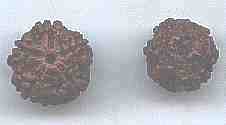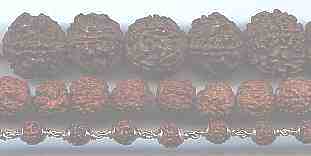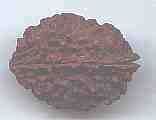The Bead Site Home>Beadmaking & Materials>Organic Materials> Sacred Plant
A Sacred Bead Plant
The Rudraksha (or Rudraksa; the "s" being pronounced "sh") is one of the most intensely studied and widely proclaimed of all sacred bead plants. Unlike the holy tulsi, it promises many advantages to those who wear it, including health benefits and the removal of sins.
|
The bead is made from the dried fruit of the tree. When fresh, the fruit is an iridescent blue, caused by layers of cellulose that wash off when submerged in water. This is a rarity in plants (you see a similar effect on peacocks and other birds) and Diamanti (2001) has suggested it is a possible reason the plant became so venerated.
And venerated it is. Much has been written about it in ancient times as well as today. This includes a chapter each in the Siva Purana and the Padma Purana (the Puranas, "that which is handed down from ancient times" are part of the sacred literature of Hinduism).
|
I have known about Rudrakshas a long time, but was not aware of the differences in sizes and colors of them. The colors are supposed to be worn by the different varnas (literally "color," but usually translated as "caste"). They are:
White Rudraksha by the Brahmin (the highest caste; the priests)
Red Rudraksha by the Ksatriya (the kings and warriors)
Yellow Rudraksha by the Vaisya (the merchants)
Black Rudraksha by the Sudra (laborers)
A dark reddish brown is the natural color. The other colors are all induced in some way.
The sales of Rudraksha are steady. But there is a mystery here. The tree is not native to India (a few have been planted in the Himalayan foothills). It is native to Southeast Asia. To this day most Rudraksha are imported to India from Java.
Java, the most populous island of Indonesia, became Hinduized some 2000 years ago. Rudraksha may have been used as a bead there long before the coming of Hinduism. Did it a play sacred role in the pre-Hindu religion of Indonesia? We don't know.
How it was adopted into Hinduism remains an enigma, but it happened some time ago. The earliest historical reference I have for the use of Rudraksha as a mark of being a Savite in India is from the eleventh century.
Rudraksha has an interesting characteristic. The exterior is divided into lobes (in Hindi "mukti"-- face or facet). These are separated by deep grooves that run from one end to the other. Most Rudraksha have five lobes. Six and four lobed Rudrakshas are not too uncommon. I have one with three. But, if you have one with a single lobe you possess a small fortune. Only one has been authenticated.
|
So valuable are Rudrakshas with one lobe that common ones are ground down to make them look like ek mukti ("one facet"). They are also carved, usually out of the hard native Eagle wood (Aegle marmelos).
Rudraksha with many facets are also valuable. The largest reliably reported one has fourteen. A dealer (whom I did not trust anyway) once offered to sell me one with seventeen, but never produced it.
|
Some References:
Joyce Diamanti 2001 More about Rudraksha.
The Bead Society of Greater Washington Newsletter 18(2): 6.
Peter Francis, Jr. 1984 Plants as Human Adornment in India.
Economic Botany 38(2): 194-209
Jennifer Gerard 2001 Rudraksa [also Pronounced Rudraksha].
The Bead Society of Greater Washington Newsletter 18(1): 4-5.
Suhas Rai 1989 Rudraksha: Properties and Biomedical Implications.
Varanasi: Gangotri Publications.
And many thanks to A. Krishnan of
rudrakshahs.com, who provided me with invaluable literature and some of the samples above.
_________________________________________________
Small Bead Businesses | Beading & Beadwork | Ancient Beads | Trade Beads
Beadmaking & Materials | Bead Uses | Researching Beads | Beads and People
Center for Bead Research | Book Store | Free Store | Bead Bazaar
Shopping Mall | The Bead Auction | Galleries | People | Events
The Bead Site Home | Chat Line | Contact Us | Site Search Engine | FAQ




